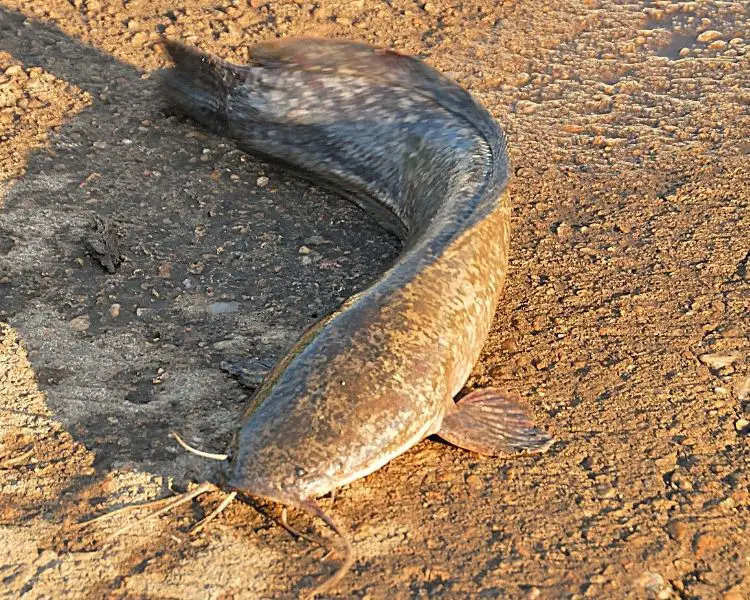Named after their unique ability to breathe air and traverse land with their pectoral fins, walking catfish are a unique, tropical subspecies of catfish native to Southeast Asia. However, should you farm walking catfish? And if so, what are the pros and cons of farming walking catfish?
Although walking catfish have various characteristics that make them an excellent fish species to farm commercially in Southeast Asia, they are illegal to import and store in America due to their status as a dangerous, resilient, and harmful invasive species.
To understand why walking catfish are illegal to farm in America, we need to explore the history of walking catfish in America and why their resilience, which at face value is a positive, actually makes them a dangerous, invasive fish species.
Should You Farm Walking Catfish In America?

Native species of catfish are farmed across America, particularly in the southern states of America, where catfish dishes are a favorite in various Cajun dishes! One of the reasons catfish are popular choices for fish farms is their resilience, adaptability, and growth potential.
Therefore, as the demand for catfish grew and advanced aquaculture methods were in their infancy, more species of catfish were imported to America from other countries in the 1960s and introduced into local fish farms. One of the imported species was walking catfish from Southeast Asia.
Once introduced to America in the early 1960s as food stock and pets, the walking catfish population boomed commercially and in the wild, mainly in Florida. In 1967 Florida passed a law that banned the importation and possession of walking catfish, reducing the population of a subspecies of catfish deemed to be an invasive species.
However, this law had the opposite effect and led to the deliberate release of walking catfish by fish farmers in the wild so that they would be found not to be in contempt of the law. Consequently, the walking catfish population grew rapidly across Florida and into approximately five other states in America.
The worst-hit state was Florida, where the walking catfish population grew from three counties in South Florida in 1968 to over 20 counties by 1978. Fortunately, the walking catfish population has remained relatively stable and hasn’t expanded into other territories in the last five decades.
However, because of the damage caused by walking catfish (see below for more details), other countries have learned from America’s mistakes and blocked the importation and storage of walking catfish.
In conclusion, while walking catfish are an excellent food source that thrives in commercial fish farms and the wild in Southeast Asia, it is illegal to farm walking catfish in America.
Pros Of Farming Walking Catfish
Although walking catfish cannot be legally farmed in America, various countries in Southeast Asia farm walking catfish. There are various positive reasons why walking catfish are farmed extensively in these countries:
Walking Catfish Are Resilient
The same characteristics that make walking catfish a dangerous invasive species in America make them an appealing species to farm in Southeast Asia.
Firstly, walking catfish thrive in environments where other fish species typically do not. Therefore, while most commercial fish farms require advanced equipment and skilled labor to monitor all aspects of artificial environments, walking catfish can thrive in warm, brackish, and/or stagnant water.
Secondly, walking catfish are resilient to disease and parasites while also sporting basic defense mechanisms such as an embedded sting in their fins to ward off predators.
Thirdly, unlike most species of fish that offer no protection to their eggs, male walking catfish build nests in underwater vegetation and protect the eggs throughout their gestation period until the young fry hatch. Consequently, walking catfish are more likely to reach adulthood earlier than other fish species.

Young Walking Catfish
Finally, walking catfish can survive periods of drought by remaining dormant, which includes several months without eating. Therefore fish farmers in rural communities can save money on fish feeding.
Furthermore, walking catfish are opportunistic eaters that will gladly eat various food items, including small fishes, aquatic insects, plant material, detritus, and dead fish.
Walking Catfish Are An Inexpensive Food Source
Because of the ease of farming, their abundance in nature, their large sizes, and their versatility as a food item, walking catfish form an important part of people’s diet across Southeast Asia as a cheap form of protein.
Furthermore, because walking catfish can breathe air and survive for months without food, the storage and transportation of live/fresh catfish can be achieved with minimal expense and effort.

Grilled Walking Catfish
Cons Of Farming Walking Catfish
Understandably, the same characteristics that make farming walking catfish attractive in countries across Southeast Asia make them a dangerous and invasive species in America. Even if they are farmed in a controlled environment, their ability to escape commercial farms by walking on land makes them extremely difficult to control!
Walking Catfish Are An Invasive Species
Because walking catfish are indiscriminate omnivores that can thrive in almost any environment, they are directly responsible for millions of dollars worth of damage to commercial fish farms in America.
The reason is that walking catfish walk from fish farm to fish farm, whereby their introduction to a pond can result in the consumption of various species of fish and vegetation in these controlled environments. Hence the need for commercial farmers to fence off ponds and waterways!
Furthermore, walking catfish have been known to carry the disease enteric septicemia. Therefore, every effort should be made to reduce the spread of this disease by limiting the contact between walking catfish and native species of fish.
Conclusion
In conclusion, while the introduction of walking catfish to America in the 1960s may have seemed like a viable method of introducing a staple and hardy fish stock into the commercial fishing market, their introduction led to the spread of a dangerous and resilient invasive species.
Therefore, most of the pros that make walking catfish a viable fishing stock in commercial fish farms in Southeast Asia make them major cons for fishing operations in America.
Sources:
Walking Catfish | Specie of Catfish found throughout the US
Walking Catfish - Invasion Biology Introduced Species Summary Project - Columbia University
